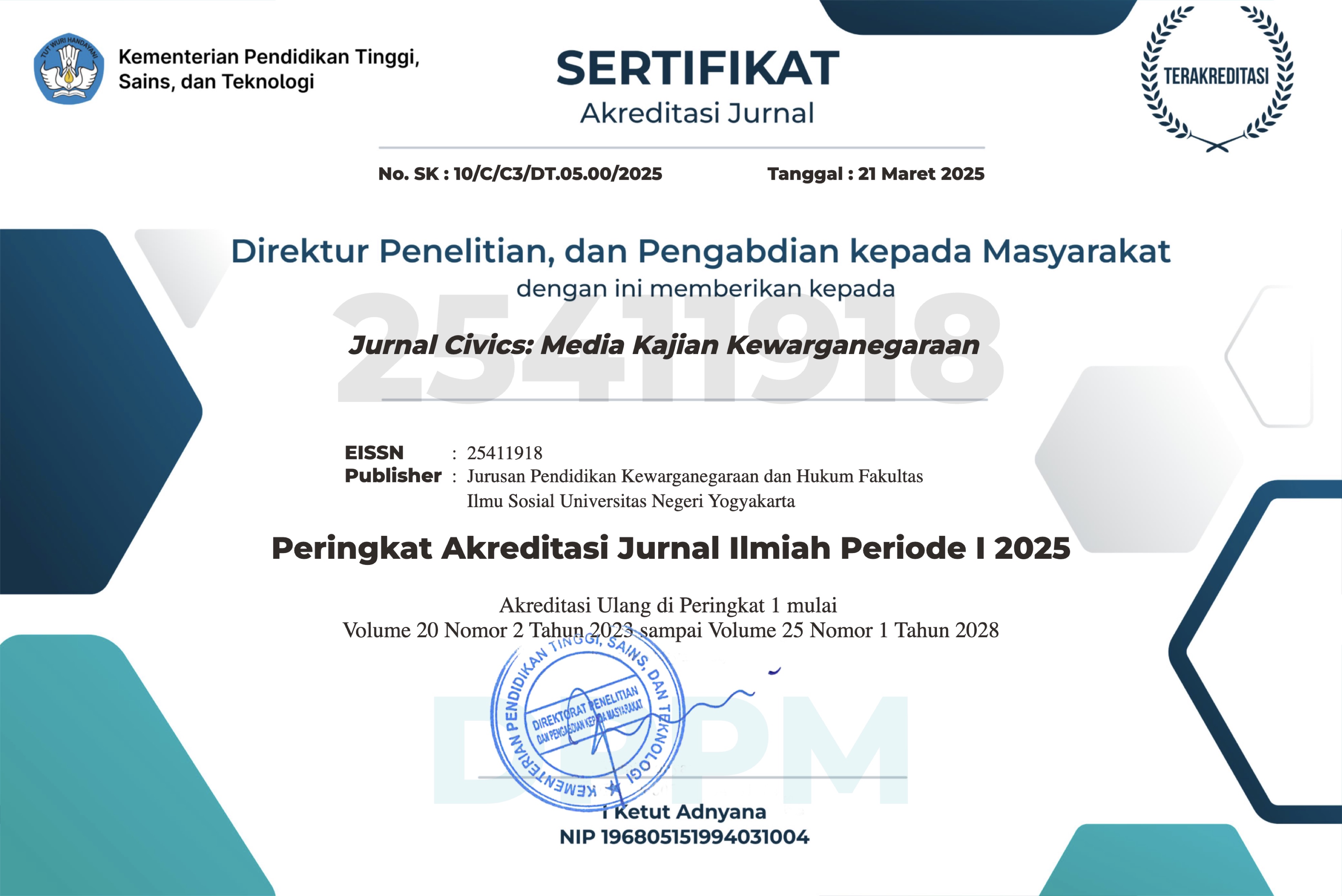Nation and the construction of masculinities in the Film Seperti Dendam Rindu Harus Dibayar Tuntas
DOI:
https://doi.org/10.21831/jc.v22i2.87209Keywords:
gender, film, masculinities, nation, patriachyAbstract
Films often represent masculinities influenced by social constructions produced and legitimised by the state. This research examines how the state shapes multiple forms of masculinity through the film Seperti Dendam Rindu Harus Dibayar Tuntas. The film critiques the hegemonic masculinity constructed by the state, while also illustrating that masculinity is not monolithic. Instead, it consists of diverse and sometimes conflicting contextually negotiated constructions. This study uses multimodal discourse analysis to explore the interrelationship between the state, masculinities, and gender representation within the film. The findings reveal that the state plays a significant role in maintaining hegemonic masculinity through policies and regulations that reinforce patriarchal norms. However, the film also opens up spaces for renegotiation, particularly for heterosexual men who fail to conform to dominant standards, allowing them to reclaim recognition within the masculine hierarchy. Furthermore, the film, produced in the Reformation era, set in the Orde Baru era, reflects a transitional moment where representations of masculinity become more fluid and contested. In a patriarchal system, while masculinity is still maintained through social control mechanisms, its boundaries are increasingly permeable, enabling cultural shifts and new gender negotiations. This research contributes to gender and media studies by showing how films, particularly Seperti Dendam Rindu Harus Dibayar Tuntas, can challenge and disrupt patriarchal constructions of masculinity shaped by the state, thereby opening up new avenues for understanding and redefining masculinity.
References
Afdholy, N. (2019). Negosiasi heteronormativitas pada performativitas transgender dalam Film Lovely Man. PARAFRASE: Jurnal Kajian Kebahasaan & Kesastraan, 19(1), 65–73. https://doi.org/10.30996/parafrase.v19i1.2368
Aminudin, A., Abrar, A. N., & Kurnia, N. (2024). The practice of body power and masculine resistance of male actors in Indonesian comedy films of the reform era. International Journal Of Humanities Education and Social Sciences, 4(1). https://doi.org/10.55227/ijhess.v4i1.1175
Arribas, B. G. (2024). Patriarchy, gender and violence: Towards a new masculinity in bell hooks. Revista de Filosofia Aurora, 36, e202431213.
Barros-Grela, E. (2022). Gender spaces in action films: The mad max franchise. In Gender and Action Films 1980-2000 (pp. 23–36). Emerald Publishing Limited.
Batool, E. (2018). Dimensions of sexual violence and patriarchy in a militarised state. Economic and Political Weekly, 53(47), 1. https://www.epw.in/journal/2018/47/review-womens-studies/dimensions-sexual-violence-and.html
Budiman, H. G., & Sofianto, K. (2018). Representasi sipil-militer dan konstruksi maskulinitas pada film Jenderal Soedirman (2015). Paradigma, 8(2), 155–173. https://doi.org/10.17510/paradigma.v8i2.220
Connell, R. (2005). Masculinities: Second edition. University of California Press.
Connell, R. W. (2017). On hegemonic masculinity and violence: Response to Jefferson and Hall. In Crime, criminal justice and masculinities (pp. 57–68). Routledge.
Connell, R. W., & Messerschmidt, J. W. (2005). Hegemonic masculinity: Rethinking the concept. Gender & Society, 19(6), 829–859. https://doi.org/10.1177/0891243205278639
Downey, L., Iacobucci, A., & Pyles, M. A. (2023). Sexualized violence and neoliberal discourse. Violence against Women, 29(3–4), 527–547. https://doi.org/10.1177/10778012221094071
Dvoryanchikov, N. V, Melnikova, D. V, Belova, E. D., & Bovina, I. B. (2024). Social representations of the body: Theory, facts and commentary (Part 1). ПСИХОЛОГИЯ И ПРАВО, 14(2), 220. https://doi.org/10.17759/psylaw.2024140312
Easteal, P., Holland, K., & Judd, K. (2015). Enduring themes and silences in media portrayals of violence against women. Women’s Studies International Forum, 48, 103–113. https://doi.org/10.1016/j.wsif.2014.10.015
Elliott, K. (2016). Caring masculinities: Theorizing an emerging concept. Men and Masculinities, 19(3), 240–259. https://doi.org/10.1177/1097184X15576203
Fatmawaty, L., Udasmoro, W., & Noviani, R. (2022). The body politics of gendered subjects in Indonesian post-reform films. Rupkatha Journal on Interdisciplinary Studies in Humanities, 14(2).
Fejes, F. J. (1992). Masculinity as fact: A review of empirical mass communication research on masculinity. Men, Masculinity, and the Media, 9–22. https://doi.org/10.21659/rupkatha.v14n2.14
Foucault, M. (1978). The history of sexuality, Volume 1: An introduction. Pantheon Books, 1, 161.
Gala, D., Khursheed, M. O., Lerner, H., O’Connor, B., & Iyyer, M. (2020). Analyzing gender bias within narrative tropes. ArXiv Preprint ArXiv:2011.00092.
Gürkan, H. (2022). The representation of masculinity in cinema and on television: An analysis of fictional male characters. European Journal of Multidisciplinary Studies, 7(1), 128–137. https://doi.org/10.26417/ejms.v5i1.p402-408
Hegarty, B. (2021). Governing nonconformity: Gender presentation, public space, and the city in New Order Indonesia. The Journal of Asian Studies, 80(4), 955–974. https://doi.org/10.1017/S0021911821000747
Heriyanto, H. (2023). Patriarchal culture, theology and state hegemony in issues of gender equality in Indonesian politics. International Conference Social-Humanities in Maritime and Border Area (SHIMBA 2023), 11–15. https://doi.org/10.2991/978-2-38476-150-0_3
Hermawan, F. F. (2017). Masculinity in Indonesian popular culture in the early era of the New Order regime. Lingua Cultura, 11(1), 47–52. https://doi.org/10.21512/lc.v11i1.1318
Heryanto, A. (2008). Popular culture in Indonesia: Fluid identities in post-authoritarian politics. In Popular Culture in Indonesia: Fluid Identities in Post-Authoritarian Politics. https://doi.org/10.4324/9780203895627
Hyunanda, V. F., Palacios Ramírez, J., López-Martínez, G., & Meseguer-Sánchez, V. (2021). State ibuism and women’s empowerment in Indonesia: Governmentality and political subjectification of Chinese Benteng women. Sustainability, 13(6), 3559. https://doi.org/10.3390/su13063559
Irawanto, B. (1999). Film, ideologi, dan militer: hegemoni militer dalam sinema Indonesia. Penerbit Media Pressindo.
Kalmár, G. (2017). Formations of masculinity in post-communist Hungarian Cinema: Labyrinthian Men. Springer International Publishing.
Kasni, N. W., Asfar, N. A., & others. (2022). Texts and images in Aquaman Movie (A multimodal discourse analysis). International Journal of Systemic Functional Linguistics, 5(1), 69–79.
Khan, S. I., Hudson-Rodd, N., Saggers, S., Bhuiyan, M. I., Bhuiya, A., Karim, S. A., & Rauyajin, O. (2008). Phallus, performance and power: Crisis of masculinity. Sexual and Relationship Therapy, 23(1), 37–49. https://doi.org/10.1080/14681990701790635
Komalawati, E. (2017). Industri film Indonesia: Membangun keselarasan ekonomi media film dan kualitas konten. LUGAS Jurnal Komunikasi, 1(1), 1–18.
Kress, G., & Van Leeuwen, T. (2020). Reading images: The grammar of visual design. Routledge.
Leal, J. (2012). American cinema and the construction of masculinity in film in the Federal Republic after 1945. German Life and Letters, 65(1), 59–72. https://doi.org/10.1111/j.1468-0483.2011.01559.x
Lehman, P. (2013). Masculinity: Bodies, movies, culture. Routledge.
Lotz, A. D. (2014). Cable guys: Television and masculinities in the 21st century. New York University Press.
Mack, A. (2017). Film as a mirror of evolving consciousness: The politics of representation, the power of social media, and shifting landscapes. California Institute of Integral Studies.
Madaan, N., Mehta, S., Agrawaal, T. S., Malhotra, V., Aggarwal, A., & Saxena, M. (2017). Analyzing gender stereotyping in bollywood movies. ArXiv Preprint ArXiv:1710.04117.
Mahmudah, Z., Udasmoro, W., & Noviani, R. (2024). Religious and cultural locality narratives in the javanese cultural film: An effort to perpetuate patriarchal culture. Critical Island Studies 2023 Conference (CISC 2023), 250–258.
Manchanda, N., & de Haan, L. (2018). Gender, nation, and nationalism. In Race, gender, and culture in international relations (pp. 80–98). Routledge.
Martin, D. M., Ferguson, S., Hoek, J., & Hinder, C. (2021). Gender violence: Marketplace violence and symbolic violence in social movements. Journal of Marketing Management, 37(1–2), 68–83. https://doi.org/10.1080/0267257X.2020.1854330
Millett, K. (2000). Sexual politics. University of Illinois Press.
Nagel, J. (2019). Masculinity and nationalism: Gender and sexuality in the making of nations. In Celebrating 40 Years of Ethnic and Racial Studies (pp. 95–122). Routledge.
Nascimento, I. R. do, Neves, A. L. M. das, Rodrigues, P. F., & Teixeira, E. (2020). Social representations of masculinities in the short film “Aids, choose your form of prevention.” Ciência & Saúde Coletiva, 25, 879–890. https://doi.org/10.1590/1413-81232020253.15802018
Noviani, R. (2018). Wacana multimodal menurut Gunther Kress Dan Theo Van Leeuwen. Hamparan Wacana Dari Praktik Ideologi, Media Hingga Kritik Poskolonial, 107–134.
Nugroho, G., & Herlina S, D. (2015). Krisis dan paradoks film Indonesia. Penerbit Buku Kompas.
Pascoe, G. J. (2015). A qualitative textual and comparative analysis of the representation of masculinity in the action and romantic comedy genres. Online Journal of Communication and Media Technologies, 5(3), 1–26. https://doi.org/10.29333/ojcmt/2513
Patel, V. (2024). Stereotyping and gender dynamics: Portrayal of women in the Bollywood films and crimes of stalking and sexual harassment. In Law and Emerging Issues (pp. 112–118). Routledge.
Pradsmadji, S. I., & Mutmainnah, N. (2022). Indonesian cinema: The battle over censorship. IKAT: The Indonesian Journal of Southeast Asian Studies, 6(1), 17–27. https://doi.org/10.22146/ikat.v6i1.71547
Sartini, N. W., & Adrian, D. (2023). Symbolic violence and discrimination in a social media comment section: A study on discriminatory discursive strategies targeting non-binary gender identity in the context of Indonesia. Cogent Arts & Humanities, 10(2), 2270287. https://doi.org/10.1080/23311983.2023.2270287
Sen, K., & Hill, D. T. (2007). Media, culture, and politics in Indonesia. Equinox Publishing.
Shapiro, M., Ingols, C., & Blake-Beard, S. (2011). Using power to influence outcomes: Does gender matter? Journal of Management Education, 35(5), 713–748. https://doi.org/10.1177/1052562911411089
Sherr, M., & Adedoyin, C. (2020). Global perspectives on manhood and masculinity. In Journal of Human Behavior in the Social Environment (Vol. 30, Issue 1, pp. 1–2). Taylor & Francis.
Turner, G. (2003). British cultural studies: An introduction. Routledge.
Udasmoro, W. (2013). Symbolic violence in everyday narrations: Gender construction in Indonesian television. Asian Journal of Social Sciences and Humanities, 2(3), 155–165.
Udasmoro, W., & Rahmawati, A. (2021). Antara maskulinitas dan feminintas: Perlawanan terhadap gender order. V. Fakultas Ilmu Budaya, UGM.
Vitelli, C. (2011). Representações das masculinidades hegemónicas e subalternas no cinema. Análise Social, 157–169. https://doi.org/10.31447/AS0003257.2011198.07
Wulan, N. (2024). norma maskulinitas pada masa orde baru-membaca sastra anak dan remaja indonesia dalam perspektif kajian maskulinitas. Airlangga University Press.
Downloads
Published
How to Cite
Issue
Section
Citation Check
License
Copyright (c) 2025 Jurnal Civics: Media Kajian Kewarganegaraan

This work is licensed under a Creative Commons Attribution-NonCommercial-ShareAlike 4.0 International License.
The authors agree to transfer the transfer copyright of the article to The Jurnal Civics: Media Kajian Kewarganegaraan effective if and when the paper is accepted for publication.
Authors and other parties are bound to the Creative Commons Attribution-NonCommercial-ShareAlike 4.0 International License for the published articles, legal formal aspect of journal publication accessibility refers to Creative Commons Attribution-NonCommercial-ShareAlike 4.0 International License (CC BY-NC-SA).










